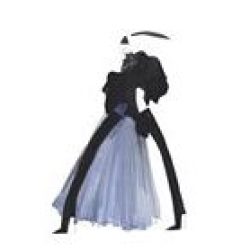The riskiest, potentially most contentious fashion show of couture week did not, as it happens, take place during couture at all. It was not held in Paris, it was not on the official schedule and it did not involve clothes to sell.
It was the exhibition “Couture/Sculpture,” a display of 65 garments by Azzedine Alaïa at the Villa Borghese, arrayed selectively among the Berninis and Caravaggios, the marble and mosaics, of the 17th-century palace. When it comes to equating fashion with art, the potential for being accused of hubris doesn’t get much greater. (Even if the idea originated with the museum’s director, Anna Coliva, and not the designer.)
“We were a little nervous, to be honest,” the artist Kris Ruhs, a member of the extended Alaïa family who had helped install the show, said at the opening. He gestured around the rooms, which were crowded with visitors — most paying homage by wearing their own Alaïas — and in the direction of Bernini’s “Apollo and Daphne.” “There’s a lot of competition,” he said.
Yet the result “was totally harmonious,” as Alber Elbaz of Lanvin said before posing with Maria Grazia Chiuri and Pierpaolo Piccioli of Valentino (and Mr. Alaïa).
Recently, it has become something of a trend to take fashion out of the costume ghetto and plunk it, without apology, in the heart of a museum, the better to link applied arts with fine arts and to demonstrate how visual inspiration of every kind has its expression in clothes. The most recent example is the Metropolitan Museum of Art Costume Institute show “China: Through the Looking Glass,” which spreads throughout three floors, including the Chinese galleries. Inserting dresses and the like into the artistic establishment is not a simple proposition, however; as Holland Cotter wrote in a New York Times review of the show, “The difference between the two disciplines is, too often, made glaring.”
Not this time, however.
According to the curator Mark Wilson, who worked with Ms. Coliva on the exhibition (and who curated two previous exhibits of Mr. Alaïa’s work, at the Groninger Museum in the Netherlands in 1997 and 2011), it took him only three hours to decide which clothes should go where.
So, for example, a white knit minidress, the skirt pleated à la gladiator, echoes the curves of a marble bust; a sinuous knit gown with a spine of sorts running down the center reflects the proportions and draped hemlines of a nearby goddess on a plinth; and a sleeveless velvet sheath, laced down the center with a priestlike collar, almost fades into the chiaroscuro of Caravaggio’s “Madonna, Child and Serpent.”
What is striking is the way the clothes sneak up on you, processed in the grand scheme of the panorama not as foreign objects but rather objects that have earned inclusion on their own merits. (It’s worth noting that Mr. Alaïa remade some of his older dresses, adjusting and elongating their silhouettes to better serve the space.) And, without the identification plaques, there would be no way to date the garments; a dress made in the 1990s looks of a piece with a dress made in 2015.
Such consistent aesthetic handwriting is rare in fashion, which places a premium on the ability to reflect what designers like to call the zeitgeist (and hence create the ever-changing fads on which the industry is built). Mr. Alaïa couldn’t care less about the zeitgeist. He’s interested in the possibilities of cloth and how it can be manipulated to idealize the body, and he has spent his career honing that idea. That is probably why its expressions work so well amid statuary dedicated in part to the acme of the human form.
“It was perfect,” said Camille Miceli, the designer of Louis Vuitton’s fashion accessories, as she left the show for the celebratory dinner in the gardens that followed the opening. Then, on the marble staircase outside the gallery, she started to twirl, her skirt flying out around her.
“Azzedine made it,” she said. “It was my wedding dress, but I don’t know how to tie the belt correctly.”
She looked back through the glass doors at the gowns beyond and fiddled with her waist. “Only he can get it right,” she said.
